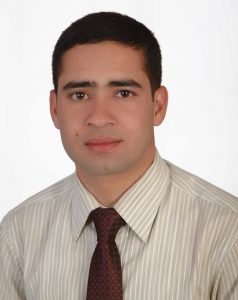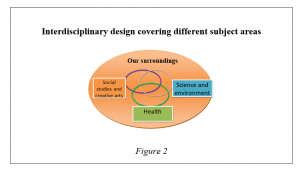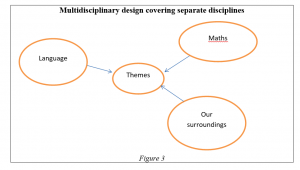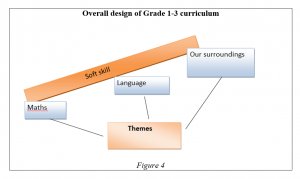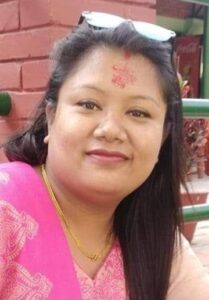
Introduction
The government of Nepal introduced Integrated Curriculum in 2019 after piloting it for a year with the goal of providing knowledge of different disciplines through related subject matters. Integrated curriculum is defined as a curriculum that interlinks learning of more than one domain or learning areas (Ghimire, 2019). So, the content is thematically organized in it. Theoretically, it is regarded as one of the best forms of curriculum design. An integrated curriculum is characterized by a systematic approach to teaching professional skills, that is, personal and interpersonal skills, and product, process, and system-building skills, integrated with engineering disciplinary fundamentals (Crawley et al. 2007). However, as a teacher, I have mixed feelings while implementing it in my classroom. In this reflective blog, I will share my experiences of implementing it especially in relation to professional development, resources, and assessment process.
In Nepal, the implementation of the curriculum is hugely dependent on teachers. Unfortunately, teachers are unknown about the curriculum until they are handed over the textbooks. They get to know that the curriculum has been revised only after going through the textbooks. Many teachers think that the textbooks have been revised, but actually, it’s the curriculum that has been revised. Surprisingly, I got access to the soft copy of the integrated curriculum only after three years of application.
Curriculum dissemination and teachers’ professional development
Generally, after the change in curriculum, the concerned authority trains the teachers before implementing it. But in my context, curriculum is implemented in school first, and only a few teachers are given training after a year or two years. So, how can teachers implement the curriculum in its true sense?
Following a similar trend, after a year of curriculum implementation, two teachers from each school in Vyas Municipality, Tanahun were called to participate in the curriculum dissemination programme and I was one of them. The facilitators of four subjects showed their slides related to their areas (Mero Nepali, Mero Ganit, My English, and Hamro Serofero). Most surprisingly, the slides simply contained a copy of the curriculum and nothing else. The facilitators read, and we listened to them like obedient students. Some of the teachers asked questions but they didn’t receive satisfying responses. I think the facilitators didn’t understand the question, and the participants didn’t understand the answers. So, the two days’ training was not so effective.
The teachers returned to their schools. Neither they implemented the curriculum nor did they exchange their learnings with their colleagues. As I was also the administrator of the school, I asked one of my colleague how they were conducting teaching-learning activities in her school. Instead, she said that the teachers who took part in the dissemination programme commented they had not understood what they were told to do and were not in the position to share their learning with others.
Later, I got an opportunity to take part in training. I had filled out the form of ETC, Tanahun, which I saw on my Facebook page in August 2022 (Shrawan). According to the information, the training would be held in the first week of September (Bhadra), but I was called for the training in October (Kartik). I attended it and learned to teach according to the purpose of the integrated curriculum. I learned different techniques to teach Mero Ganit (Mathematics) while teaching My English, Mero Nepali, and Hamro Serofero (My surrounding) and; to use teachers’ guides (TG). I learned to use an evaluation form to keep records of students’ learning achievements. I learned to keep records and build a portfolio of the students. As it was a ten-days training with two days devoted for each subject area including students’ assessment. We were told how to use teacher’s guide. Frankly speaking, I had never used a teacher’s guide before. Moreover, I had rarely heard about it and never seen the teachers using and talking about it.
After the training, I hurried to reach my school and apply what I learnt. I downloaded the Teacher’s guide from www.moecdc.gov.np; however, I couldn’t find the TG of all subjects of all classes. Despite that, I found the training useful for me to teach and assess my students.
Access to resources and materials
As teaching and testing are the two sides of a coin, I had to assess my students’ listening skills in English. In their workbook, students were asked to listen to recordings and do given activities, but I was helpless because I was unknown about the recordings. I searched on CDC website but couldn’t find them. Then, I contacted the municipal education department and they told they would get back to me but never did so. I reached out the trainer, who facilitated the assessment segment in the training and explained my problem and he provided me with the contact information of a CDC officer. I called them and they asked me to contact them later and when I called later, their phone was switched off. Eventually, I couldn’t find the materials to assess listening skill of my students.
Needless to say that the teachers must be well equipped with the resources for effective teaching and learning processes but teachers in our context are struggling to access the fundamental resources. On the other hand, teachers are blamed for not imparting quality education. How can a teacher contribute to students’ education? How can a teacher provide better education without resources? It is said that teachers must be resourceful, but how?
Assessment policy and practices
The curriculum indicates that the students must be assessed regularly and provided feedback. So, I tried to collect the assessment template from one of the stationeries where I usually used to go for school related documents and materials. I couldn’t find them even after making couple of attempts and I accessed the softcopy of the curriculum and printed the assessment forms using my office computer. I started to keep records of my students progress in it. Later, the municipality called for a meeting to discuss the examination date and other issues just before the first term (quarter). They provided a booklet of assessment forms. It was frustratingly late because we were supposed to keep records of students learning achievement from the very first day.
The curriculum has talked about the formative assessment of students and workbooks are designed based on it. Students are to be assessed after completion of each theme, so that we can evaluate whether they have achieved the learning outcomes of the particular theme or not. All they have to do is assess their students and keep records in the given format and make a portfolio of each student.
Although it became easier for me, it was not the same for other teachers. When the second terminal examination was about to begin, there was a debate among the teachers whether to follow the curriculum or not for students’ assessment. Only a few teachers favored the curriculum, which envisions continuous assessment of students instead of paper-pencil test but teachers and parents are habituated to it. They don’t want to change the status quo. Instead they would want to continue with the traditional test, which is against the spirit of the curriculum. However, almost all the teachers wanted to continue with the terminal paper-pencil tests. They argued that the parents aren’t happy until their children appear in the written examination. It seemed that they were fencing themselves and making excuses due to the time-taking assessment system in a new format.
When the third quarter of last year was coming to the end, teachers were asking me about the process of assessment procedures of the students. I explained them many times what I knew but it was not possible to explain entire process over the phone. I requested them to read the curriculum and teacher’s guide. However, I don’t think they did so. Some teachers even asked me to take a photo of the assessment form and send them pictures of the record. It was surprising how a photo could help them to assess their students! Actually, the whole process is described very well in the curriculum. However, they do not access them either because they have poor digital literacy or are reluctant to implement the change in the new curriculum.
Conclusion
The government appoints specialists to develop the curriculum, and the specialists develop the curriculum. They might accomplish their job after designing the curriculum but curriculums are only successful once they are implemented effectively, so the concerned authority should also equally think about the implementers and implementation process. Teachers are still obliged to enter classrooms without any ideas about curriculum and instruction it envisions. They are also unlikely to be aware of the learning outcomes, pedagogy and assessment procedures in the new curriculum. Despite these problems, teachers are compelled to teach, which definitely hinder the effective implementation of the curriculum.
To summarize, the concerned authority must make sure that every teacher gets a copy of curriculum before it is implemented in classrooms. The teacher’s guide and curriculum must be available easily, like students’ textbooks. Teachers’ feedback must to collected widely before rolling out the new curriculum. Similarly, all teachers must be trained well before implementing new curriculum or policy. Mohr and Welker(2017) stated that “if curricular change is to happen, professional development ought to be a focus, and teachers’ perspectives should be central to the process.” Training after one or two years of curriculum implementation is worthless. Teachers should get chances to discuss their issues with the concerned authorities regarding their problems. Last but not least, the teachers themselves must also be active and curious to learn, so that they don’t have to always depend on others for implementing or leading change.
References
Crawley, E. F., Malmqvist, J., Östlund, S., Brodeur, D. R., Edström, K., Gunnarsson, S., & Gustafsson, G. (2007). Integrated curriculum design. Rethinking Engineering Education: the CDIO Approach, 77-101.Retrieved from https://www.researchgate.net/publication/234118103_Integrated_Curriculum_Design
Curriculum Development Center (2006). Primary education curriculum (grade 1-3). Sanothimi Bhaktapur: Curriculum Development Center.
Mohr, K., & Welker, R. W. (2017). The role of integrated curriculum in the 21st century school. https://irl.umsl.edu/dissertation/688
About the Author: Laxmi Shrestha is an M.Ed. from Aadikavi Bhanbhakta Campus, TU. She is an English teacher in a public school, Tanahun. Her interest in writing includes EMI, Second Language Acquisition, Sociolinguistics, and Language Teaching.
